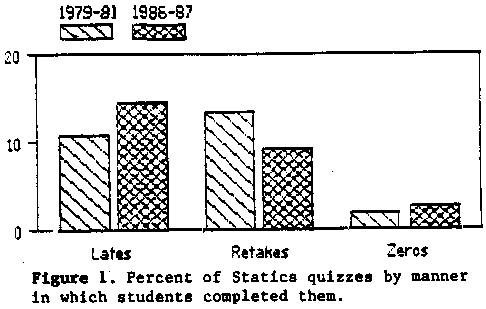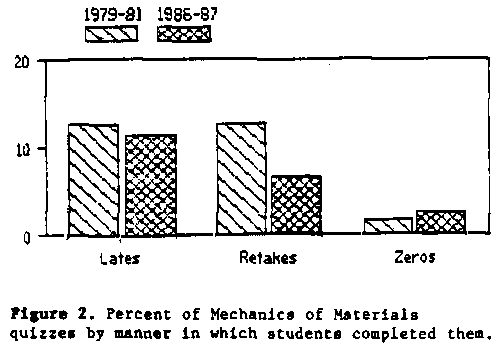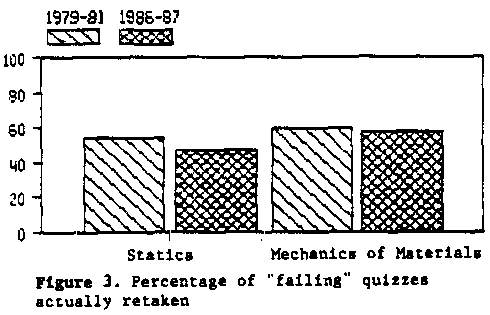
Wallace S. Venable, Associate Professor, Mechanical & Aerospace Engineering
West Virginia University
1987 Frontiers In Education Conference Proceedings
Fifteen sections of engineering mechanics courses were studied to see if there were identifiable differences in student study behavior between the 1986-87 school year and the period between 1979 and 1981. This year's students in Statics had significantly more late work. Several other differences examined were not significant.
Complaining about the lack of dedication to study of current students is a classic behavior of "mature" faculty members. It is said that Socrates complained about a decline in student quality, and I have no doubt that the "problem" extends into prehistoric times.
Generally such complaints are based on anecdotal information. Few instructors measure student behavior other than quality of work (grades), let alone keep long term records. In fact, remarks about student behavior are often offered primarily in defense of unpopular grade assignments, or as an excuse for failing to meet course objectives.
In the fall of 1986, I felt that I was observing a marked decline in the willingness of students in my section of statics to take the work "seriously." Students seemed to be too casual about both promptness and quality of work. In addition to complaining to my colleagues, (who all agreed with me) I decided to examine several possible measures of student behavior which I feel reflect attitude.
Since the class was a "programmed" section of Statics, I had a sizable volume of historical records at my disposal. I could conduct a long term study within a short time frame.
Data collected at West Virginia University in conjunction with "programmed" mechanics courses provides an unusual opportunity to examine a number of long-term aspects of student behavior. This course has been conducted in much the same manner for nearly two decades. There are, of course, minor variations in course content and procedures, and rotations in teaching assignments, but the general configuration is quite steady. Sometimes it is even possible to select classes for study which are matched by method, content, and instructor, but which were conducted in different years.
"Programmed" sections of mechanics are taught from programmed instruction textbooks. Students are required to take a quiz after each of thirty to thirty-five study units, in addition to four hour exams and a departmental final exam. Most quizzes and examinations are taken in class, but students are given the opportunity to take early, late, and limited retake work in a learning laboratory. Operation of the courses as well as the effects of the method on student achievement, has been described in previous publications. [1]
In preparing the proposal for this paper, I made a preliminary comparison between sophomore statics classes conducted in the Fall of 1979 and my class in the Fall of 1986. Rather than looking at groups on the basis of achievement scores, I examined daily work, in the form of quizzes, for evidence of student motivation.
On each measure examined, the more recent classes rate more poorly. My fall semester students showed a four-fold increase in the percentage of quizzes not taken within a week after the scheduled time. They showed a nineteen percent increase in total "lates." They displayed a thirty-nine percent increase in work eligible for "retaking," but a thirty percent reduction in the rate of actually taking advantage of the opportunity to retake low quiz grades.
On the basis of these results, I decided to undertake a larger and somewhat more rigorous review of available data.
Within the "programmed" sections of courses, students are expected to take quizzes on an almost daily basis. In the development of the courses, it seemed unreasonable to expect students to attend every class. First, we permitted students to take a limited number of quizzes late. With the introduction of interest in "mastery learning," we added provision for students to retake quizzes on which they received low grades. Then later, we added flexibility by letting students take quizzes early when they were at least a day ahead of schedule.
Students are given a printed schedule listing when each quiz will be given in class. Most students take the majority of their quizzes in class.
Under the rules in effect for all of the classes studied here, students were permitted to take up to five quizzes late without making any explanation. Students with problems such as major illnesses are permitted additional late work, but excessive unexcused late work is penalized.
If a student does not complete a quiz within a week of the scheduled date, and the instructor does not excuse the tardiness, a grade of zero is assigned. This zero is then averaged with the actual grade on the quiz, when and if it is taken.
Students are also allowed to retake any quiz on which they receive a grade of less than seventy percent. Such retaking is not required, but is generally encouraged by the instructors. When students retake, they receive the average of the two grades, so there can be a significant return for their effort if it results in better knowledge of the material.
For this study, several behaviors recorded on the quiz score sheets were considered to be reflections of students' attitude toward work. Admittedly, these behaviors also reflect differences in illness rates, pressures of jobs and other courses, and intellectual abilities, but these were considered to be negligible.
The primary behaviors analyzed were:
Two courses were studied, statics and mechanics of materials. At WVU, statics is taken by all engineering students, generally in the first semester of the sophomore year. Mechanics of materials is taken by all students except electrical engineers, and the student level varies from sophomore through senior.
All data was taken from class records after the courses were completed. None of the instructors nor students knew of the study at the time data was recorded.
Sections of the course analyzed were limited to regular semester classes taught by American born faculty or graduate instructors. Most were taught by faculty with ten or more years experience. Data was collected for all 1986-87 sections meeting these requirements. Data wee also collected for a selection of classes from the years between 1978 and 1984.
Over the years there have been changes in the last date on which students were permitted to withdraw from courses, although the circumstances under which students drop seem to be relatively constant. In order to reduce any effects relates to withdrawal practices, student records were included only if they had been actively taking quizzes the last two or three assignments.
Eleven sections of statics including approximately 340 students were analyzed. Four sections of mechanics of materials with about 150 students were included.
Raw counts of the selected behaviors within each section were divided by the number of students and required quizzes to establish percentage of occurrence. These results were then averaged by course for the time periods. Bar graphs of these results for percentage of late work, percentage of quizzes retaken, ant number of "zeros" are shown in Figure 1 and Figure 2.


These graphs appear to confirm the original hypothesis that students are, indeed, worse today.
In the process of collecting and analyzing the data, it became clear that there is considerable variation between sections, as well as the considerable variation expected between students. Accordingly, I decided to make statistical tests of the significance of the various differences.
Using each class as a separate sample, means and standard deviations were calculated and subjected to a "t-test." Only three differences are significant at the 0.05 confidence level.
The first significant difference is in percentage of late work in statics. Statics students during this past year took 35 percent more late quizzes than would be expected on the basis of past experience. This finding is, in fact, significant at the 0.01 level.
Second, in both courses, students in 1986-87 retook a significantly lower number of quizzes. On further examination of the data, however, I observed that they had also received far fewer grades below 70 percent. On adjusting the retake rate for eligibility (students may not retake a score of over 70) it was found that there wee no difference. Figure 3 shows the differences in retake rate as a percentage of eligibility.

Based on the statistical evidence presented here, I conclude that today's engineering sophomore is more casual in his attitude toward late work than students of five or ten years ago. The data from mechanics of materials suggests that statics instructors still get them to "shape up or ship out."
The data on differences on the number of quizzes retaken suggests another hypothesis. If today's student is failing fewer quizzes at WVU, is it because she works harder, is smarter, or because our undergraduate graders are leas willing to give failing grates. I suspect the latter, partly because we have made changes in our procedures for selecting graders.
In addition I was again struck by the great variation between class sections which actually occurs, even when sections should be assumed to be similar. We have, in the past, observed very noticeable, but generally not statistically significant, differences in achievement between classes taught by a single instructor in a given semester. Bar graphs and averages tend to be misleading when describing human behavior, unless information on variances is available.
Obviously this study has failed in its attempt to prove that today's engineering student has significantly poorer attitudes toward the educational tasks assigned. Much further work is needed if we are to maintain our traditional outlook.
Plants, H.L. and Venable, W.S., "Programmed Instruction is Alive & Well in West Virginia," Engineering Education, Vol. 75, No. 5, February 1985.